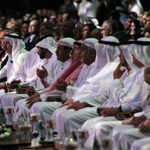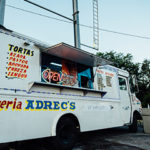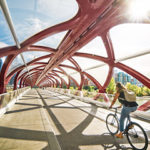“We have to figure out ways to stand out, all of us,” said Maura Gast, executive director of the Irving Convention & Visitors Bureau.
Gast would know. Irving is a second-tier convention city flanked by two major destinations, Dallas and Fort Worth — both of whose identities were cemented long ago. (Fort Worth touts “cowboys and culture”; Dallas tends to play off its size, with the tagline “Big things happen here.”) To compete, Irving has had to carve out its own special place in the landscape, both figuratively and literally. In 2011, the city opened the Irving Convention Center at Las Colinas, which, with its severely angular, copper-plated design, sought to set Irving apart from its neighbors in a visually memorable way.
“We could have built a very functional, utilitarian building,” Gast said. “Probably could’ve saved a little bit of money in the process, but had we taken that approach, all of the land we bought would have had to be used for the convention center, and because we went vertical with the building instead of horizontal, we freed up more of the land so that we could create a district.”
The unique design has served the destination well. Repeat business is booming, according to Gast, plus the facility has served as something of a replacement for Irving’s since-demolished Texas Stadium, the onetime home of the Dallas Cowboys, who moved to the new AT&T Stadium in Arlington, Texas, in 2009. And starting this year, Irving will develop a convention district that includes a headquarters hotel and the Irving Music Factory.
“We in particular felt like we weren’t going to replace that emotional connection of [the Dallas Cowboys] overnight, but we needed to at least begin a new physical icon or a physical connection with Irving,” Gast said. “We weren’t asking [the architects] to replace the emotional tie, but we needed something that would be iconic and a good symbol of what the city is about.”
Like Irving, other successful second-tier meeting destinations understand the advantages of having a signature asset when it comes to competing in the marketplace. It can be a simple activity, like Virginia Beach’s oyster farms, or more complex, like San Jose’s technology industry — but each one represents something unique. Here’s how 21 different cities are using a signature asset to benefit their meetings business.
Columbus, Ohio
Short North Arts District
Columbus’ funkiest neighborhood, the Short North Arts District, runs along North High Street for more than 20 blocks. It’s the perfect escape for meeting attendees, who can step outside the Greater Columbus Convention Center and already be in the thick of the neighborhood. “This neighborhood is authentically Columbus,” said Brian Ross, president and CEO of Experience Columbus. “Lined with hundreds of local restaurants and entertainment, unique art galleries, and one-of-a-kind boutiques, it’s a go-to destination when people visit our city.”
It’s also representative of Columbus’ most fashionable denizens. As home to major fashion retailers like L Brands (think Henri Bendel and Victoria’s Secret) and the Columbus College of Art & Design, Columbus has one of the highest number of fashion designers per capita in the country, resulting in a cluster of independent clothing stores in the Short North Arts District.
Austin, Texas
Live-music venues
More than 250 live-music venues contribute to the beat of this Southwestern city — which not surprisingly calls itself “the Live Music Capital of the World.” Step out for a night on Sixth Street and it’s possible to catch the next Willie Nelson or Gary Clark Jr., two musicians who spent their early days circulating the Austin music scene. “It’s not just one genre,” said Shilpa Bakre, senior communications manager for the Austin Convention & Visitors Bureau. “You will hear anything and everything on any given night. Yes, of course we have country, but there’s blues, jazz, hip hop, R&B, acoustic….”
And because many of the city’s most popular music venues line the streets that surround the Austin Convention Center, attendees can leave their last meeting of the day and five minutes later be front and center at a live show.
Birmingham, Alabama
Barber Vintage Motorsports Museum
A Southern city well known for its diversity and history, Birmingham is also thick with museums. Among them is a hidden gem for auto enthusiasts — the Barber Vintage Motorsports Museum, which houses a collection of 1,200 vintage and modern motorcycles and racecars, and holds the Guinness World Record for the largest collection of cars made by Lotus. Even more reason for groups to get revved up is the museum’s adjacent 2.38-mile racetrack and Porsche Sport Driving School. The museum also has one of the largest motorcycle collections in the world, displaying models from 20 countries and more than 200 manufacturers.
Spanning 840 acres, the museum and surrounding Barber Motorsports Park have numerous spaces for private events, from an atrium and 59-seat theater to the facility in its entirety, which can hold up to 900 guests. “The track and the museum serve as the perfect and unusual backdrop for meetings of various sizes,” said Barry Hoehn, director of convention sales for the Greater Birmingham Convention & Visitors Bureau, who added that the venue has been used for everything from product launches for Porsche to training sessions for Mercedes-Benz.
Milwaukee, Wisconsin
Henry W. Maier Festival Park
“Milwaukee’s impressive 75-acre Henry W. Maier Festival Park along beautiful Lake Michigan is home to the world’s largest music festival, Summerfest, as well as ethnic festivals running all summer long,” according to Jeff Baryenbruch, executive director of sales for VISIT Milwaukee. It’s this outdoor space, which has been home to Summerfest since 1968, that has helped the city earn the title “City of Festivals.” The park also neighbors some of Milwaukee’s most popular attractions, including Discovery World and the Milwaukee Art Museum.
“With its 10 permanent outdoor stages, a 23,000-seat amphitheater, and a variety of VIP decks,” Baryenbruch said, “the festival park is unique in the country and the perfect fun-filled, value-added proposition for summer conventions in Milwaukee.”
Long Beach, California
The Pacific Ballroom at the Long Beach Arena
For five years, the Long Beach Arena hosted the TED conference, so when it came time to add a new ballroom, Long Beach drew inspiration from the event’s always-forward-thinking design. With unique features like the largest-ever “flying grid,” which can adjust the ceiling to almost any height, the new Pacific Ballroom is ahead of its time, just like TED.
“We decided to renovate the aging sports arena and make many of the TED innovations permanent installations that would allow a meeting planner full creative control of the space,” said Bob Maguglin, director of public relations for the Long Beach Convention & Visitors Bureau. “At 45,000 square feet, the ballroom doubled the capacity of our largest ballroom in the city. This allowed us to book groups that could not have used Long Beach previously due to lack of space.”
Ottawa, Canada
The Canadian War Museum
When designing its immersive, interactive exhibits, Ottawa’s Canadian War Museum veers far from the typical see-and-learn dioramas and deep into multisensory territory. For example, using faux clouds of gas in the museum’s new “Fighting in Flanders — Gas. Mud. Memory.” exhibit helped reimagine how Canadians fighting in World War I had to contend with mustard, phosgene, and chlorine gas.
The museum is known for putting as much creativity into its private events as it does its exhibits. “Imagine the impact of a gala dinner amid the tanks and airplanes of the LeBreton Gallery, overlooking Parliament Hill and downtown Ottawa,” said Jantine Van Kregten, director of communications for Ottawa Tourism. “The natural setting of the museum along the banks of the Ottawa River (just steps from downtown) is beautiful, and the architectural features encourage reflection and awe. The hospitality expertise of the museum’s staff (and that of other Ottawa venues) is unmatched, well-versed as they are in hosting VIPs, from heads of state to titans of industry.”
Minneapolis, Minnesota
A strong Fortune 500 community
When it comes to meetings in Minneapolis, one of the city’s strongest draws isn’t what, it’s who. Minneapolis has the second-highest number of Fortune 500 headquarters per capita in the country, ranging from Target to Ameriprise Financial. Not only have these companies supported the city’s local meetings market as a treasure trove of built-in attendees, sponsors, and expert speakers, they have had a major hand in helping win big-time events, including Super Bowl LII in 2018.
“Our bid committee co-chairs — top leaders and CEOs from U.S. Bank, Carlson, Ecolab — brought their connections and experience working with private- and public-sector partnerships to compete and win this event,” said Kristen Montag, communications manager for Meet Minneapolis.
Indianapolis, Indiana
The Indy 500
More than 300,000 visitors pack Indianapolis every Memorial Day weekend for the Indy 500, and as the event has grown over the years, so has the city’s capacity to handle all kinds of events — not just those requiring a minimum of 500 horsepower.
“As the Racing Capital of the World, Indy has taken the most iconic racing event on the globe, held at one of the world’s premier event facilities — the Indianapolis Motor Speedway — and blown it into a month-long festival steeped in tradition,” said Chris Gahl, vice president of Visit Indy. “Year after year, Indy continues to shine on the international stage during the Indy 500, as it will during the 2015 NCAA Men’s Final Four and did at Super Bowl 2012. Repeated success is indicative of how the destination excels at hosting major conventions and special events.”
Salt Lake, Utah
Mormon Tabernacle Choir
Salt Lake can be moving in many ways — its almost unnervingly majestic natural beauty, its adrenaline-pumping outdoor sports — but one of its most uplifting experiences is indoors. “Visitors to Salt Lake have many opportunities to experience unique, natural wonders — the nearby Wasatch Mountain range, our ‘Greatest Snow on Earth,’” said Scott Beck, president and CEO of Visit Salt Lake. But “one that we’re particularly proud of is the world-renowned Mormon Tabernacle Choir. This 360-person chorus, sometimes called ‘America’s Choir,’ performs free weekly concerts each Sunday morning and rehearsals on Thursday evenings. Groups and meeting attendees have a rare opportunity to witness firsthand a musical embodiment of Salt Lake’s service mentality while participating in a tradition that dates back to 1929.”
Louisville, Kentucky
Bourbon
With 95 percent of the world’s bourbon produced in Kentucky, this spirited city is at the center of both a reignited Southern tradition and a mushrooming food-and-beverage scene. “With the resurgence of brown spirits and the worldwide popularity of Kentucky bourbon, Louisville is spotlighting this unique cultural heritage with new attractions, new distilleries, and the growing Urban Bourbon Trail, which features 34 of the world’s top bourbon bars in the city,” said Stacey Yates, vice president of marketing communications for the Louisville Convention & Visitors Bureau.
Many of those bars come group-ready, such as Proof on Main. Located inside the 21c Museum Hotel, Proof can cater events within the hotel’s larger spaces, and has a collection of 75-plus Kentucky-made bourbons for sampling. “Combined with a growing culinary scene,” Yates said, “the bourbon tradition is piquing people’s interest in Louisville and providing a great hook for meetings.”
Kansas City, Missouri
Country Club Plaza
Although the art and architecture of Seville, Spain, provided the inspiration for Kansas City’s Country Club Plaza, the 55-acre landmark is actually the birthplace of one of the most prevalent architectural fixtures of modern American life — the shopping center. Designed in 1922, the plaza has earned a spot on The Project for Public Spaces’ list of “60 of the World’s Great Places” for its well-thought-out design.
“This historic, 15-block neighborhood was modeled after our sister city of Seville, Spain, with beautiful Moorish architecture, fountains, statues, and more than $1 million of outdoor artwork,” said Denise DeJulio, executive director of sales for Visit KC. “It’s also one of our most popular entertainment districts, with fantastic shopping and dining experiences that you can only find in KC.”
Nashville, Tennessee
Music
Anyone who has visited Nashville knows that its heart thumps to its own countrified beat. And you better believe that Music City uses that musical acumen when it comes to attracting groups. “We are unique in that music is our brand as well as our product,” said Kay Witt, chief sales officer for the Nashville Convention & Visitors Corporation.
The CVC often sends out videotaped invitations and welcome messages to groups from Nashville artists, and also works closely with meeting planners to incorporate music elements throughout a conference or trade show. For example, the CVC often customizes its monthly radio show on Sirius/XM, “Music City Connection: Heroes Behind the Hits,” for clients at little or no cost. “Fortunately, we are home to countless musicians,” Witt said, “so booking an artist is much more cost-effective in Nashville when you don’t have to account for travel expenses.”
Charlotte, North Carolina
NASCAR Hall of Fame
So often, convention centers come in tandem with hotels, arenas, or other blank-space venues, but few can say they’re attached to one of the city’s biggest attractions. That’s the case in Charlotte, where the Charlotte Convention Center is directly connected to the fastest joint in town, the NASCAR Hall of Fame. The 150,000-square-foot monument to all things racing has spaces for private events, including a 278-seat theater, and numerous exhibits, such as “Glory Road,” a tribute to NASCAR’s six generations of history, chronicled through 18 race cars.
And like the convention center to which it’s joined, the Hall of Fame sits in the heart of Charlotte’s vibrant downtown. “We are really fortunate to have such a walkable cityscape,” said Laura Hill, director of communications for the Charlotte Regional Visitors Authority. “There’s no shortage of options when attendees have some downtime to explore the city.”
San Jose, California
Technology
In San Jose, technology is the undercurrent humming through everything, from the city’s economy to its art. Just check out the San Jose McEnery Convention Center, whose high-tech Idea Tree sculpture was inspired by innovation itself. “As the Capital of Silicon Valley, San Jose has the unique ability to provide clients and their attendees with an opportunity to collaborate and engage face-to-face with the geniuses developing today’s coolest gadgets and revolutionizing technologies at companies such as Adobe, eBay, TiVo, Netflix, and nearby Apple, Facebook, and Yahoo!,” said Karolyn Kirchgesler, CEO of Team San Jose. “Team San Jose’s recent partnership with the City of San Jose to extend free Wickedly Fast Wi-Fi throughout the convention center and other public facilities we manage reflects our commitment to providing world-class technology for our clients — all that you’d expect from the most forward-thinking destination.”
Tampa Bay, Florida
Ybor City
“For more than a century,” said Charlena Owens, marketing sales and media relations representative for Visit Tampa Bay, “Ybor City was a melting pot for Cuban, Spanish, German, and Italian immigrants who worked at the local cigar factories that made Tampa Bay the ‘Cigar Capital of the World.’”
Today, those cigar factories house the bars, nightclubs, and restaurants that make up Tampa Bay’s liveliest neighborhood — but visitors can still catch a hand-rolling demonstration from a handful of cigar makers. “We send our meeting attendees to Ybor City because it’s authentic Tampa Bay,” Owens said. “Ybor City helped make Tampa Bay the region it is. It’s the place where visitors can have a real Cuban sandwich and a café con leche, and the place where visitors can experience where the current city was birthed and get a feel for where the city is going.”
Irving, Texas
Irving Convention Center at Las Colinas
The Irving Convention Center at Las Colinas is the perfect example of how, when lacking a little edge, a second-tier convention city can invent its own. “When we began to design the Irving Convention Center at Las Colinas, we knew we had to approach things differently,” said Maura Gast, executive director of the Irving Convention & Visitors Bureau. “We were never going to be the biggest kid on the block, and we needed to be able to stand out in other ways that our customers would view as positive.”
As a result, the bold geometric exterior “doesn’t look like your standard-issue, utilitarian, institutional box with docks,” Gast said. The dramatic design — by Studio Hillier, who also designed LVMH Tower in New York City — stands in deep contrast to the flat Texas landscape that stretches out around it. “But looks aren’t everything, and so we had to make sure the building was designed to function well,” Gast said. “The spaces are laid out efficiently, and the vertical design of the building makes it easy to move throughout the building.”
Portland, Oregon
Shopping
Portland thrives on its innate quirkiness, and one of the best ways to explore that is through shopping. “Portland is a ‘City of Makers,’ and shopping arcades like Union Way, conveniently located in downtown, offer both national and local retailers,” said Jeff Miller, president and CEO of Travel Portland. “Delegates and their guests can fill empty spaces in their bags (or buy a new one to fill) with everything from hand-crafted leather goods, to clothing by a local designer, or culinary takeaways like salts, candies, and coffee. And it’s all tax-free.”
In addition to using the Travel Portland app to automatically see shopping points of interest close to their location, visitors can tweet questions at #inpdx to receive tips from the DMO as well as locals.
Providence, Rhode Island
WaterFire
If there’s one element that sums up Providence, it’s creativity. Three renowned educational institutions — Rhode Island School of Design, Johnson & Wales University, and Brown University — all help fuel that artistic fire. And during the months between May and November, visitors can watch it come alive in downtown Providence, at the crux of the city’s three rivers.
“WaterFire, which features nearly 100 bonfires floating in the rivers of Providence, is our city’s signature event,” said Thomas Riel, vice president of sales and services at the Providence Warwick Convention & Visitors Bureau. “Part art installation and part street carnival, it draws tens of thousands of visitors each time it occurs. Meeting planners will sometimes work with our bureau and with WaterFire to sponsor one during their meeting. Other planners simply luck out, as WaterFire usually occurs about twice a month from May through November. Either way, it is a magical experience that separates Providence from other cities.”
Savannah, Georgia
22 perfect squares
Tucked away on a verdant cusp of Georgia coastline, Savannah has set the stage for countless Southern-based films, including “Forrest Gump” and “Midnight in the Garden of Good and Evil.” Integral to its inimitable Southern Gothic atmosphere is the city’s original, 18th-century-era layout of 24 squares (22 of them still intact), which lure visitors back again and again to explore its web of moss-draped gardens, monuments, and antebellum homes.
“Savannah is especially unique in its city plan,” said Jeremy Harvey, vice president of marketing and communication for Visit Savannah. “There are 22 park-like squares placed in a grid pattern throughout Savannah that make it so you can walk every bit of the 2.5-square mile Historic District. This provides a great environment for breaks between meetings, with the squares themselves offering unique venues for networking events.”
Virginia Beach, Virginia
Oyster farming
One of the best ways to see a destination’s true nature is to experience how its food is gathered. In Virginia Beach, where the ocean is vital to the destination’s identity, there’s no better way to do this than through a Pleasure House Oyster Farm Tour. The oysters from the nearby Lynnhaven River have long been considered a delicacy — even served to royalty — and Pleasure House lets visitors explore a farm up close, explaining the intricate process of raising and harvesting oysters and even inviting them to pull on waders to catch a few of their own.
“Lynnhaven River oysters are experiencing a revival,” said Tiffany M. Russell, director of public relations for the Virginia Beach Convention & Visitors Bureau. “Whether an oyster bar is part of your catered event or you offer an afternoon excursion for attendees to pick their own, you’ve created an unforgettable meeting moment.”



